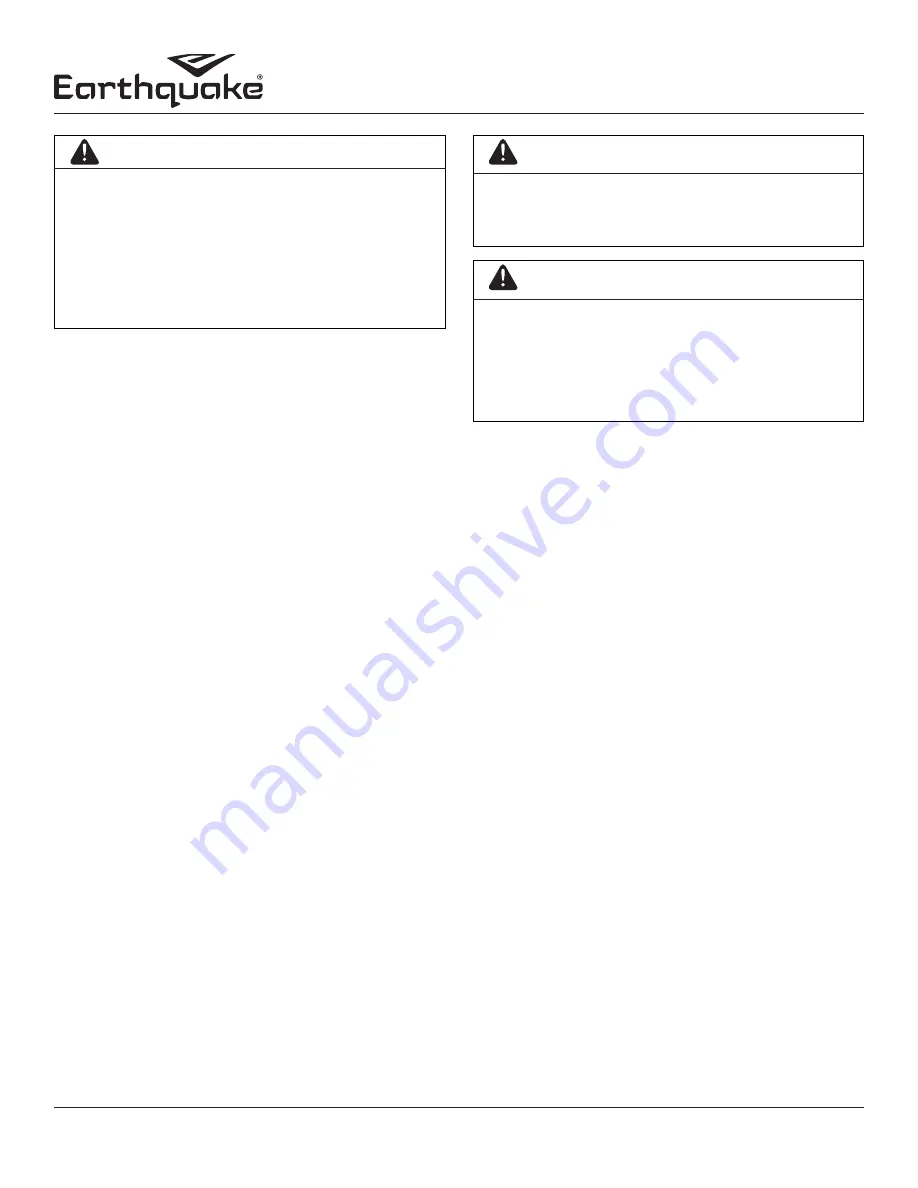
Operator's Manual
MC440 4-Cycle Cultivator
Check for parts online at
www.getearthquake.com
or call 800-345-6007 M-F 8-5
5
ENGINE SAFETY PRECAUTIONS
If your product comes with a separate engine manual, be
sure to read and follow all safety and warning precautions
outlined there, in addition to any in this manual.
Preventing Carbon Monoxide Poisoning
• Always start and run engine outdoors. Do not start or run
engine in an enclosed area, even if doors or windows are open.
• Never try to ventilate engine exhaust indoors. Carbon
monoxide can reach dangerous levels very quickly.
• Never run engine outdoors where exhaust fumes may be
pulled into a building.
• Never run engine outdoors in a poorly ventilated area where
the exhaust fumes may be trapped and not easily taken
away. (Examples include: in a large hole or areas where hills
surround your working area.)
• Never run engine in an enclosed or partially enclosed area.
(Examples include: buildings that are enclosed on one or
more sides, under tents, car ports or basements.)
• Always run the engine with the exhaust and muffler pointed
in the direction away from the operator.
• Never point the exhaust muffler towards anyone. People
should always be many feet away from the operation of the
engine and its attachments.
•
Do not change the engine governor settings or over-speed
the engine.
Gasoline Fires and Handling Fuel Safely
Use extra care in handling gasoline and other fuels. They are
flammable and vapors are explosive.
•
When storing extra fuel be sure that it is in an appropriate
container and away from any fire hazards.
•
Prevent fire and explosion caused by static electric discharge.
Use only nonmetal, portable fuel containers approved by the
Underwriter’s Laboratory (U.L.) or the American Society for
Testing & Materials (ASTM).
•
Always fill fuel tank outside in a well ventilated area. Never
fill your fuel tank with fuel indoors. (Examples include:
basement, garage, barn, shed, house, porch, etc.) Never
fill tank near appliances with pilot lights, heaters, or other
ignition sources. If the fuel has to be drained, this should
be done outdoors. The drained fuel should be stored in a
container specifically designed for fuel storage or it should
be disposed of carefully.
•
Never remove the fuel cap or add fuel with the engine
running. Stop engine and allow to cool before filling.
•
Never drain fuel from engine in an enclosed area.
•
Always wipe up excess (spilled) fuel from engine before
starting. Clean up spilled fuel immediately. If fuel is spilled,
do not start the engine but move product and fuel container
from area. Clean up spilled fuel and allow to evaporate and
dry after wiping and before starting.
•
Allow fuel fumes/vapors to escape from the area before
starting engine.
•
Test the fuel cap for proper installation before starting and
using engine.
•
Always run the engine with fuel cap properly installed on
the engine.
•
Never smoke while refilling engine fuel tank.
•
Do not store engine with fuel in fuel tank indoors. Fuel and
fuel vapors are highly explosive.
DANGER
ENGINES GIVE OFF CARBON MONOXIDE, AN ODORLESS,
COLORLESS, POISONOUS GAS. CARBON MONOXIDE MAY
BE PRESENT EVEN IF YOU DO NOT SMELL OR SEE ANY
ENGINE EXHAUST. BREATHING CARBON MONOXIDE CAN
CAUSE NAUSEA, FAINTING OR DEATH, IN ADDITION TO
DROWSINESS, DIZZINESS AND CONFUSION.
IF YOU EXPERIENCE ANY OF THESE SYMPTOMS, SEEK
FRESH AIR AND MEDICAL ATTENTION IMMEDIATELY.
CAUTION
HOT GASES ARE A NORMAL BY-PRODUCT OF A
FUNCTIONING INTERNAL COMBUSTION ENGINE. FOLLOW
ALL SAFETY INSTRUCTIONS TO PREVENT BURNS AND
FIRES.
WARNING
NEVER ALTER OR MODIFY THE ENGINE FROM THE
FACTORY. SERIOUS INJURY OR DEATH MAY OCCUR IF
ENGINE IS MODIFIED OR ALTERED.
WHEN WORKING ON OR REPLACING PARTS FOR THE
ENGINE OR PRODUCT, YOU MUST ALWAYS FLIP THE ON/
OFF SWITCH TO THE OFF POSITION.






































